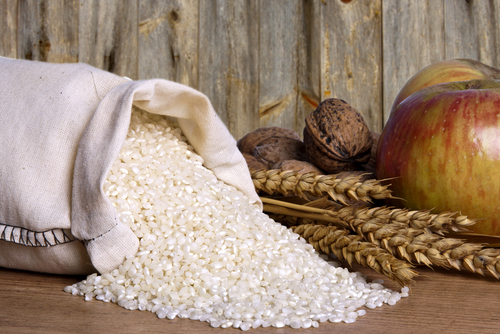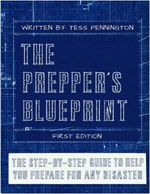
Last year, I devoted a better part of a year encouraging all of you to get prepped in the 52 Weeks to Preparedness series. This program was so successful, we made it into a book. Hopefully, you have taken action and stocked up now that food prices are getting out of hand. Today, I want to ask you to stretch yourself and take things to the next level by encouraging you all to take another step towards self-reliance.
Commercial food sources have become corrupted with genetically-modified foods, hormones/antibiotics, pesticides and neurotoxins. This is no way to keep your family healthy. Your food pantry should be stocked with healthy foods, and growing them yourself may be the only option left.
If you are just beginning your food pantry, ideally, you want to store long lasting shelf stable foods that your family normally consumes, as well as find foods that serve multiple purposes. Having tools on hand to dehydrate and preserve extend the shelf life exponentially. Here are 25 foods to use as a starting point. Many of the foods listed in the previous link can be grown in a garden or on your property. By taking steps to grow your own food, you can naturally begin to restock grains, fruits and vegetables, spices, canned meals, and even plant-based oils for your pantry. Most importantly, you have total control on how the food sources are grown. An added benefit to growing your own food, is that they attract deer, wild pig, birds and other animals you can lure for food sources.
What You Need to Get Started
Proper Equipment: Your investment in this venture is simple: garden supplies, seeds and small trees, a few tools (dehydrators, oil expellers, canning equipment) and time. Although growing your food is more of an agrarian type of pantry system, this is the best way to learn self-reliance as well as the best way to help you learn how much food your family needs to thrive.
Start Small: As with all prepping endeavors, start small and don’t get in over your head. Start a vegetable/herb garden and then accent it with additional beds for berries and grains. Once this is established, start adding fruit bearing and nut bearing trees.
Be Efficient: Further, creating an efficient gardening area equipped with a water source for easy irrigation, a composting area and natural sources for manure will help you make the most use of the space you have. The following image best describes this type of gardening space.

6 Essential Food Types To Grow Your Own Food Pantry
- Herb garden – Herbs are one of the easiest additions you can make to a garden. Best of all, they like a little abuse and don’t require as much water as vegetables do. A trick that I have learned is to plant my herbs along the perimeter of the garden. This is the driest area of the garden and they are very happy there. Further, since they are usually small in stature, you can easily trim them and make more room in the middle of the garden for vegetables. When the herbs are ready to be harvested, get your dehydrator ready! You can make teas, spice blends, herbal extracts, emulsions and medicinal tonics. Read about these 6 Fool-Proof Tips for a Successful Garden
- Vegetable garden – There is no better feeling that growing your own food, in my opinion. It’s very rewarding and the taste from fresh grown produce is like no other. Start with the easiest seeds to grow and then consider adding a berry patch and perennial vegetables to help you make the most of your time. By growing perennials, you’ll create a more diverse garden that ultimately needs less from you: You’ll spend less time working and more time harvesting. Perennial are also a great way to create an edible landscape. Wild leeks, onions, asparagus, artichokes, rhubarb and sorrel are some of the delicious perennial additions you can add for future harvests.
- Legumes – Legumes make up a large portion of our food pantry. Beans, peas and lentils are the richest source of vegetable protein, as well as a good source of fiber, calcium, and iron. Aside from using legumes in the usual manner, legumes can also be ground into an alternative flour source, sprouted for a fresh vegetable source, or made into spreads such as hummus. To learn more about why having a protein in your shtf diet is essential, click here.
- Fruit trees – Having wild fruit trees in abundance not only provide edible food for humans and livestock, but they also attract needed pollinators such as bees and hummingbirds. The crab apple tree, mayhaw tree, mulberry tree, pear tree, persimmon tree and plum tree offer food for animals such as the deer, quail, goose, pheasant, and turkey. Most of the fruit from these trees can be dehydrated or made into tasty jams, jellies, and fillings for pies. Further, look into finding the dwarf-variety of fruit trees. There are many varieties of very small fruit trees now, including semi-dwarf, dwarf, dwarf, mini, and colonade trees. It would seem that you can grow fruit just about anywhere, but there are some catches to it. For instance, you will need more than one fruit tree variety to produce fruit. Also, you need to look into what zone you are living in to ensure the fruit trees can grow there. Fruit trees can also be grown in a greenhouse – if you have sufficient ceiling height and space. Some people put them in large pots on wheels, to move them in and out. Others plant them in the ground in the greenhouse.
- Grains – Grains are essential to any pantry; they can be ground into flours, added to stretch meals or made into delicious cereals. Start growing the easy to grow grains and learn how to incorporate them into your favorite recipes. Growing grains such as wheat, spelt, oats, rice, amaranth, buckwheat, barley, millet, and rye in your backyard doesn’t require any special machinery, and you may be surprised at how little space it takes to grow a substantial supply of homegrown grains. A typical family uses about a bushel of wheat (60 pounds) a year, plus about ¼ to ½ bushel of other grains. Given reasonably good conditions, you should be able to grow a bushel of wheat in a 20- by 50-foot plot (1,000 square feet).
- Nuts and Seeds – Although a majority of nuts and seeds come from trees, there are some seed producing plants that can be grown in the garden. Sunflowers, pumpkin seeds, chia seeds, hemp seeds and peanuts can be grown in the garden and used to make cereals, added to dishes or eaten all on their own.
Learn more about essential trees, fruits and berries
Click here to learn about cultivating your own sugars
Growing your own food sources does not require an immense amount of space to start. We can all be sustainable – even if you’re living in the city. Those living on properties as small as a 1/2 acre can easily make use of the land you have to create a sustainable garden. Self reliance is not an unreachable goal – it requires planning, patience and initiative. Begin stretching yourself and take this preparedness journey to the next level.





























